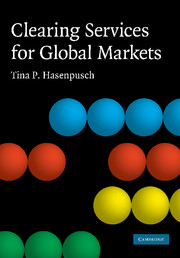 Clearing Services for Global Markets
Clearing Services for Global Markets Book contents
- Frontmatter
- Contents
- List of figures
- List of abbreviations
- Acknowledgements
- Foreword
- 1 Introduction
- 2 Setting the stage – definitions and industry setting
- 3 Defining the core issues – efficiency and network strategies
- 4 Collecting empirical insights – introduction to the empirical study
- 5 Analysing costs of derivatives clearing – transaction cost studies
- 6 Exploring theoretical basics – scale effects in clearing
- 7 What theory reveals – framework for efficiency analysis of network strategies
- 8 Checking theory against reality – case studies of network strategies
- 9 Quantifying the efficiency impact – European network strategies
- 10 Introducing the future network economy – development of the clearing industry
- 11 Summary, discussion and recommendations for future research
- Appendices
- Bibliography
- Index
11 - Summary, discussion and recommendations for future research
Published online by Cambridge University Press: 19 January 2010
- Frontmatter
- Contents
- List of figures
- List of abbreviations
- Acknowledgements
- Foreword
- 1 Introduction
- 2 Setting the stage – definitions and industry setting
- 3 Defining the core issues – efficiency and network strategies
- 4 Collecting empirical insights – introduction to the empirical study
- 5 Analysing costs of derivatives clearing – transaction cost studies
- 6 Exploring theoretical basics – scale effects in clearing
- 7 What theory reveals – framework for efficiency analysis of network strategies
- 8 Checking theory against reality – case studies of network strategies
- 9 Quantifying the efficiency impact – European network strategies
- 10 Introducing the future network economy – development of the clearing industry
- 11 Summary, discussion and recommendations for future research
- Appendices
- Bibliography
- Index
Summary
This study examined both the efficiency and structure of the clearing industry. Clear-cut definitions together with a concise characterisation and descriptive analysis of the current state of the clearing industry set the stage for the following analytical objectives. Besides defining the efficiency of clearing and identifying ways to measure it, this study aimed to determine the efficiency impact of various integration and harmonisation initiatives within the clearing industry. The ultimate research objective was to identify the network strategy best suited to increase the efficiency of clearing, benefiting all clearing members. Based on these findings, the most preferable future clearing industry structure was identified and recommendations on the industry's future development were delivered. Although the focal point of the research was the European exchange-traded derivatives clearing industry, the results of the analysis were eventually applied to European exchange-traded cash equities clearing and to European clearing in a global context.
This final chapter summarises the study's most important findings (section 11.1). A critical discussion of the research results leads to recommendations for future research (section 11.2).
Summary of research results
This section summarises the study's most important findings, chapter by chapter.
Chapter 2 – Setting the stage – definitions and industry setting
Depending on the type of service provider, the process of clearing encompasses a number of services. Most clearing houses today act as a so-called central counterparty (CCP).
- Type
- Chapter
- Information
- Clearing Services for Global MarketsA Framework for the Future Development of the Clearing Industry, pp. 428 - 440Publisher: Cambridge University PressPrint publication year: 2009


